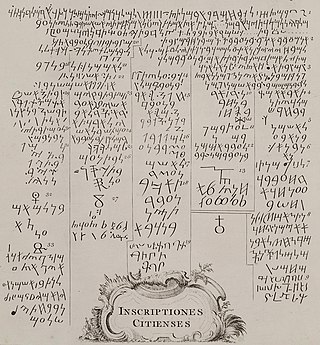Top Qs
Timeline
Chat
Perspective
Pococke Kition inscriptions
Phoenician and Semitic inscriptions From Wikipedia, the free encyclopedia
Remove ads
The Pococke Kition inscriptions were a group of 31 Phoenician and 2 non-Phoenician inscriptions found in Cyprus and published by Richard Pococke in 1745. In describing Kition (modern Larnaca), Pococke wrote: "the walls seem to have been very strong, and in the foundations there have been found many stones, with inscriptions on them, in an unintelligible character, which I suppose, is the antient [sic] Phoenician..."[1]
The Phoenician inscriptions are known as KAI 33 (CIS I 11), KAI 35 (CIS I 46) and CIS I 57-85. They represent some of the most important finds in Phoenician and Semitic language studies, as they were used by Jean-Jacques Barthélemy in his decipherment of the Phoenician language.
Only one of the inscriptions still survives, in the Ashmolean Museum - all the rest were destroyed in construction work in 1749.[2][3]
Remove ads
Surviving inscription – KAI 35

The sole surviving inscription is a marble funeral stone, numbered "2" in Pococke's sketch, measuring 12 x 3 x 3 inches; the inscription is in memory of a deceased wife. The inscription was brought to England by a Dr. Porter of Thaxted, and presented to Oxford University by Charles Gray MP in 1751.[4][5] It was published many times, first by Pococke, and then by John Swinton, Richard Chandler, Jean-Jacques Barthélemy, Wilhelm Gesenius,[5] and Johan David Åkerblad.[2]
Today it resides at the Ashmolean Museum, with accession number AN1974.325.[6]
Remove ads
Concordance
Gallery
- A page from Barthélemy's publication of his decipherment of Phoenician: "Inscriptions Phéniciennes, trouvées en Chypre par M Richard Pococke". No. 1 is Pococke's No. 2 (KAI 35), and No. 3 is Pococke's No. 4. The other two are Hebrew transliterations of the same inscriptions.
- Concordance with the Corpus Inscriptionum Semiticarum (see table at bottom)
- The only surviving inscription, today at the Ashmolean Museum
Notes
Wikiwand - on
Seamless Wikipedia browsing. On steroids.
Remove ads



